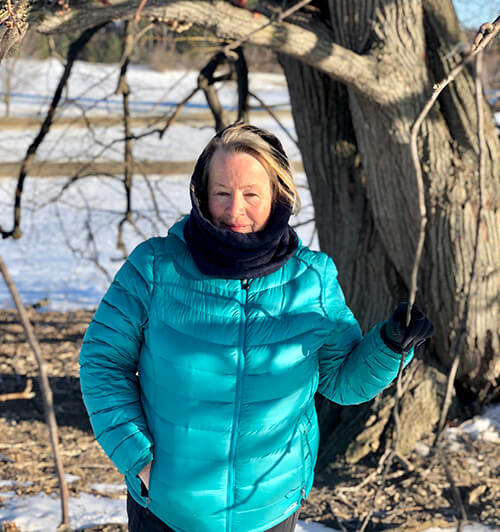Meg Berlin: Making her land bird friendly
When Meg Berlin and her then-husband visited a friend who lived in Charlotte almost 25 years ago, they fell in love with the area and decided to buy some land and build a house. Berlin’s initial plot was 50 acres, but she eventually acquired another 15 from a neighbor who lived just north of her.

Sixty-five acres is a lot to manage by herself, but Berlin is working hard to ensure that it’s suitable for local wildlife. Her land abuts the Town Park on one side and town-owned land on two other sides. “It’s like a little island,” she said. Berlin’s first goal was to eradicate invasive species like honeysuckle and buckthorn. “I’m nowhere near where I’d like to be on that,” she confessed. Roughly 10 years ago, she found another target for her efforts when she began working with the U.S. Department of Agriculture’s Natural Resources Conservation Service (NRCS).
“They were looking at the Town Park,” Berlin said, “and they looked at my land since it was contiguous. They were trying to create habitat suitable for the golden-winged warbler.” Berlin isn’t a birder but she appreciates nature, so she decided to take part in the program. “They started on a small parcel eight or nine years ago,” she said. “They paid me so I could hire people to remove trees and honeysuckle bushes.” The initial work was done with massive machines, and Berlin was charged with following up by supporting the new growth of species more suitable for golden-winged warbler habitat like low-growing willows and northern dogwood. “The warblers and others weave their nests and lay their eggs on thin, low-lying branches,” she said.
In addition to golden-winged warblers, there is a blue-winged warbler that enjoys the new habitat, as well as a hybrid between the two birds. Every year, people from Audubon Vermont visit the land to check on the bird population. “They come over at 6 a.m.,” Berlin said. “They play a recording to attract the birds, catch them in a net, take down information such as the bird’s age, band them, and let them go again.” Audubon gives Berlin a list of all the birds they’ve seen on her land. “They consider this to be a success,” she said.
Berlin has continued to maintain other parts of her property, noting that it took a great deal of work to get her additional 15-acre piece to the point where she could even walk through it. “It was six or seven years ago that I caught the bug of taking care of the land more seriously,” she said. “There was a lot of undergrowth and I brush-hogged the paths.” Last year, NRCS asked if Berlin would be willing to increase the size of the test parcel. “That’s a godsend,” she said “because I’ve been paying someone to come in and remove the invasives and the dead trees.” Since then, another 15 acres has been cleared for warbler habitat.
Berlin spent three years on the Charlotte Conservation Commission. “I love all wildlife,” she said. “Being here for 24 years has been an incredible education for me.” While she was on the Conservation Commission, Berlin was asked to work with the iNaturalist program. “It’s a global network of scientists and citizen-scientists,” she said. “If you go out and see an animal or plant, you take a photograph and indicate where it was, and then a scientist will affirm or identify it for you and make a record of it. It’s a way for a town to assess its natural assets. I did that for a while and took it very seriously.” The program was perfect for Berlin since she is a photographer who has sold her work and taken part in several exhibitions. “I’m really interested in photographing the natural world and landscapes,” she said.
When Berlin first moved to her property in Charlotte, she was enchanted by several old maple trees that framed her view of Lake Champlain and the Adirondacks. “One by one they died,” she said, “and that helped me think more about the landscape.” In the process of clearing her land of honeysuckle and buckthorn, Berlin discovered an ancient pear orchard. She is trying to get the trees pruned with dreams of having someone harvest the fruit for hard cider or brandy. “I went from just seeing everything grown up and taking over,” she said, “to really trying to hew to the natural habitat of what is supposed to grow here.”

